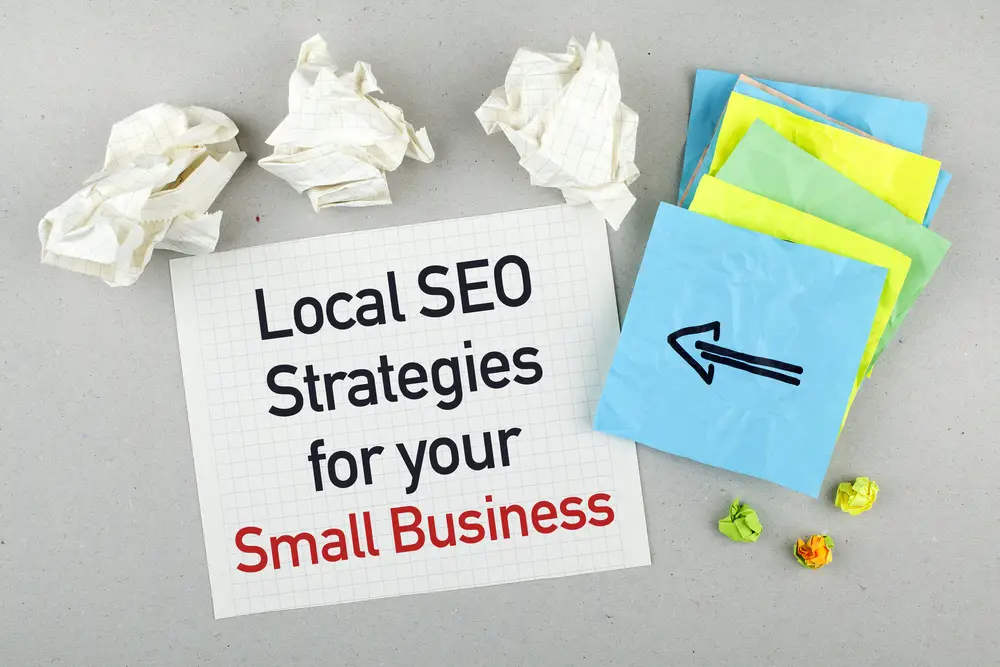SEO is a powerful tool that can help you drive unlimited organic and high-quality traffic to your website. But, achieving these goals requires implementing an effective SEO strategy.
If you want to avoid wasting your SEO efforts, it is essential to read this article. it will help you form a powerful SEO strategy.
Today, we will delve into detail on how to create a successful SEO strategy that can help you achieve your goals.
What is an SEO Strategy?
An SEO (Search Engine Optimization) strategy is a plan of action to improve the visibility and ranking of a website or web page in search engine results pages (SERPs).
The ultimate goal of an SEO strategy is to increase organic traffic to a website or web page by optimizing its content, structure, and other factors that search engines consider when ranking pages.

How to Create an SEO Strategy that Aligns With Your Business Goals?
Let’s dive into the important steps to build a perfect SEO strategy from basic to advance.
Industry Analysis
To create a good SEO strategy, you need to study the industry where your business is located.
This includes researching trends, and competitors, and finding opportunities.
This helps you create an SEO plan that is tailored to your business goals.
During an industry analysis, you can find popular keywords that people use to search for businesses like yours.
You can also see what your competitors are doing to rank well on search engines and find ways to improve your website.
You can create content that answers your customers’ questions and addresses their needs.
Industry analysis is a crucial step in making a successful SEO strategy that makes your business stand out and attract more customers.

Understanding the basics of SEO
Search Engine Optimization (SEO) is the practice of optimizing your website to increase its visibility and rank higher on search engines like Google.
The goal of SEO is to improve the quality and quantity of traffic to your website by making it more attractive and relevant to search engine algorithms.
Some basic components of SEO include:
- On-page optimization involves optimizing content and metadata on your website.
- Off-page optimization involves building high-quality backlinks and social media shares.
Other important factors include:
- Keyword research
- Content creation
- Monitoring and analyzing your website’s performance

Read: Why Your Business Needs SEO in 2023 [17 Reasons]
Setting realistic goals and objectives
Before beginning your SEO strategy, it’s crucial to set realistic goals and objectives that align with your business objectives.
Here are some examples of common objectives for an SEO strategy:
- Improving search engine rankings: This objective focuses on improving the ranking of your website on search engine results pages (SERPs) for relevant keywords.
- Increasing website traffic: This objective aims to increase the number of visitors to your website, which can be achieved through various strategies like keyword optimization and content marketing.
- Generating more leads or sales: This objective focuses on converting website visitors into customers, which can be accomplished through conversion optimization techniques.
To set effective goals for your SEO strategy, you need to consider the following factors:
- Your current baseline performance: You need to have a clear understanding of your current website’s performance metrics like traffic, rankings, and conversions to set realistic goals.
- Industry benchmarks: You should also analyze your competitors and industry benchmarks to set goals that are both ambitious and achievable.
- Your target audience: It’s essential to understand your target audience’s needs and preferences, so your goals align with their expectations.
Setting realistic and achievable goals based on these factors will help you build an effective SEO strategy that yields significant results.

Setting SMART goals
SMART goals are important when creating an SEO strategy. Here’s what each letter means:
- Specific: Make sure you know exactly what you want to accomplish.
- Measurable: Set goals that you can track and measure progress towards.
- Achievable: It is important to ensure that your objectives are both realistic and achievable.
- Relevant: Ensure that your goals are related to your business objectives.
- Time-bound: Have a specific deadline for when you want to achieve your goals.
For instance, a SMART SEO goal could be to increase your website’s organic traffic by 20% in six months by enhancing your on-page SEO and content.
This objective is specific, measurable, achievable, relevant, and time-bound, providing a clear and actionable roadmap for your SEO strategy.

SWOT analysis
The SWOT analysis is a useful tool for creating an effective SEO strategy. SWOT stands for Strengths, Weaknesses, Opportunities, and Threats.
It involves identifying the internal and external factors that impact your business’s SEO performance. Here are some important points to consider during a SWOT analysis:
- Strengths: Identify your business’s strengths, such as your website’s technical elements, content quality, and backlink profile. Leverage these strengths to improve your SEO performance.
- Weaknesses: Identify your business’s weaknesses, such as slow site speed, low-quality content, or a lack of backlinks. Address these weaknesses to improve your SEO performance.
- Opportunities: Identify opportunities for growth, such as new keywords with high search volume or a gap in the market that your business can fill. Take advantage of these opportunities to improve your SEO performance.
- Threats: Identify threats to your business, such as new competitors or changes in search engine algorithms. Mitigate these threats to minimize their impact on your SEO performance.
A SWOT analysis can help you create an SEO strategy that uses your strengths, improves your weaknesses, and takes advantage of opportunities while dealing with potential threats.
This can help you achieve your SEO goals while being prepared for changes in the market.

Identifying your target audience
Identifying your target audience is a critical first step in creating an effective SEO strategy.
Knowing who your audience is will help you create content that speaks to their needs and interests, which in turn can drive more traffic to your website.
Here are some additional details and tips for identifying your target audience:
- Demographics: Understanding your audience’s demographics, such as age, gender, location, and income, can help you tailor your content and marketing efforts to their specific needs.
- Interests and pain points: Knowing what your audience is interested in and what challenges they face can help you create content that addresses those interests and pain points.
- Search behaviors: Understanding how your audience searches for information online can help you optimize your content for relevant keywords and search terms.
Here are some tools you can use to find your target audience:
- Google Analytics: This tool provides valuable data about your website visitors, including their demographics, interests, and search behavior.
- Social media insights: Social media platforms offer insights into your followers’ demographics, interests, and engagement with your content.
- Customer surveys: Surveys can help you gather feedback from your audience about their needs, pain points, and interests.
In addition to identifying your target audience, it’s also important to analyze your competitors’ audiences. Here are a few suggestions on how to accomplish this:
- Identify your competitors: Start by pinpointing the primary competitors within your industry or niche.
- Analyze their audience: Look at your competitors’ social media followers, website visitors, and customer demographics to identify any gaps or opportunities.
- Use this information to inform your strategy: Use the insights you gather to inform your content strategy and marketing efforts.
When you get to know your target audience and analyze your competitors’ audience, you can create a more powerful SEO strategy that speaks to the needs and interests of your audience.

Conducting thorough keyword research
Keyword research is a critical aspect of SEO because it helps you understand the language and search terms that your target audience uses to find information related to your products or services.
Here are some additional details and tips for conducting keyword research:
- Start with a seed keyword: Begin by identifying a primary keyword related to your business or industry. This keyword will serve as the foundation for your research.
- Use keyword research tools: Tools such as Google Keyword Planner, SEMrush, and Ahrefs can help you identify additional keywords related to your primary keyword.
- Look for long-tail keywords: Long-tail keywords are more specific and less competitive than short-tail or business generating keywords. They often have higher intent and are more likely to drive targeted traffic to your website.
- Consider search volume and competition: Look for keywords with a decent search volume but lower competition. These keywords are easier to rank for and can still drive significant traffic to your website.
- Group keywords by topic: Organize your keywords into groups based on their relevance to specific topics or themes. This will help you create content that targets specific search terms and phrases.
Conducting keyword research and focusing on long-tail keywords with lower competition and higher intent, will assist you to create content that ranks well on search engines and drives targeted traffic to your website.

Read: 40+ Answer the Public Alternatives [Free + Paid Both Included]
Keyword Clustering
Creating a keyword cluster is a useful step in an SEO strategy that involves grouping related keywords together to improve the relevancy and organization of your content.
Keyword clustering helps search engines understand the context of your content and makes it easier for users to find what they are looking for.
- Identify a primary keyword that is relevant to your content.
- Find related keywords and phrases that are semantically similar to your primary keyword.
- Group these keywords together.
- Use the keyword cluster to create high-quality, informative content.
- Make sure that your content has value for your audience.
Creating keyword clusters, allows you to improve your website’s topical authority helps gain Google’s trust and achieve more rankings in SERP.
Keyword clustering also helps to build inbound marketing funnels and get more relevant audience.
Analyzing your competitors’ SEO strategies
Analyzing your competitors’ SEO strategies is an essential step in creating an effective SEO strategy for your business.
Knowing your competitors’ strategies can help you improve your own.
Here are some important points to keep in mind when analyzing your competitors’ SEO strategies:
- Use tools like SEMrush, Ahrefs, and Moz to gather data on your competitors’ websites.
- Look for their top-ranking keywords and identify which keywords they are ranking for that you are not.
- Analyze their backlinks to see where they are getting their link juice from and identify potential link-building opportunities for your own website.
- Look at the content on their website and identify topics that are performing well and resonating with their audience.
Analyzing your competitors’ SEO strategies can help you create your own effective SEO strategy.
You can learn from their strengths and weaknesses, including their top-ranking keywords, backlinks, and content.
After gathering this data, you can stay ahead of the competition and achieve your SEO goals.

Read: Find Competitors Keywords With Manual Method And Tools
Create high-quality and optimized content
Creating high-quality, optimized content is essential for driving traffic to your website and improving your search engine rankings.
Your content should be informative, engaging, and relevant to your target audience, and should add keywords and metadata that align with your SEO strategy.
Here are tips for writing powerful content that connects with the readers:
- Write for your audience: Keep your audience in mind and write content that is tailored to their needs and interests.
- Use clear and concise language: Write in a clear and concise manner to ensure that your message is easy to understand.
- Provide value: Make sure your content provides value to your audience, whether it’s by solving a problem, answering a question, or providing new insights.
- Edit and proofread: Always edit and proofread your content to ensure it’s error-free and easy to read.
- Stay current: Keep your content up-to-date and relevant by staying informed about the latest trends and developments in your industry.
To create high-quality, optimized content, you should conduct keyword research and create a content calendar that aligns with your target audience and business goals.

Content Gapping
To improve your SEO, find content gaps in your industry and fill them with relevant content.
Content gaps are areas that are not covered in-depth by you or your competitors.
Analyze your industry and competitors’ websites to identify these gaps, and provide unique perspectives and added value to the topics.
Use keyword research tools to find high-volume keywords that your competitors are not targeting. Filling content gaps improves search engine rankings and attracts new visitors interested in the topics you cover.
Blogging
Implementing a blog on your service website can be an effective way to enhance your SEO strategy.
Blogging allows you to create new, relevant, and informative content that can attract potential customers and keep your current ones engaged.
It can also help to establish your website as an authority in your industry and improve your trust with reputation.
Regularly publishing blog posts that incorporate relevant keywords can increase your website’s visibility on search engines.
This, in turn, can attract more organic traffic from relevant keywords.
Additionally, blog content can be shared on social media, generating more visibility and potentially driving more traffic back to your website.

Ensuring your website is mobile-friendly
With more and more users accessing the internet on their mobile devices, having a mobile-friendly website is essential for improving your search engine rankings and user experience.
Your website should be optimized for mobile devices, with responsive design and fast loading speeds.
To ensure your website is mobile-friendly, you can use tools like Google’s Mobile-Friendly Test and PageSpeed Insights.
You should focus on optimizing your website’s design, content, and loading speeds for mobile devices, and ensure that it provides a seamless user experience across all devices.
Optimizing your website’s speed and performance
Optimizing your website’s speed and performance is essential for improving user experience and search engine rankings.
A slow website can increase bounce rates and decrease user engagement, which can negatively impact your SEO performance.
To optimize your website’s speed and performance, you can use tools like Google’s PageSpeed Insights and GTmetrix.
You should focus on optimizing your website’s images, minifying your CSS and JavaScript files, and enabling caching to improve loading times.

Improving your website’s user experience (UX)
Improving your website’s user experience is essential for keeping users engaged and improving your search engine rankings.
Your website should be easy to navigate, visually appealing, and provide valuable content and functionality to users.
Here are some more detailed points on improving website user experience:
- Conduct user testing: You can gather feedback from real users on how they interact with your website and identify pain points and areas for improvement.
- Analyze user behavior data: Using tools like Google Analytics, you can track how users navigate your website, where they spend the most time, and where they drop off. This data can help you find out which parts of your website require improvement and could be better.
- Optimize website design: A well-designed website with clear navigation, easy-to-read fonts, and an attractive layout can keep users engaged and improve their experience.
- Improve website content: The content on your website should be valuable, informative, and relevant to your target audience. By providing helpful content, users are more likely to stay on your website longer.
- Streamline website functionality: Your website should be easy to use and provide a seamless experience. Make sure all links and buttons work properly and that your website is mobile-friendly.
By improving your website’s user experience, you can not only improve your search engine rankings but also create a positive impression with your audience and increase engagement on your website.
Implementing on-page SEO best practices
On-page SEO involves optimizing the content and metadata on your website to improve your search engine rankings.
Best practices of On-page SEO include incorporating relevant keywords, optimizing your content’s metadata, and using header tags and internal links to improve readability and navigation.
To implement on-page SEO best practices, you should find low-competition keywords and comprise relevant keywords into your content and metadata.
You should also optimize your content’s metadata, including titles, descriptions, and alt tags, and use header tags and internal links to improve navigation and readability.

Building a strong internal linking structure
Internal linking means creating links from one page on your website to another.
The purpose of internal linking is to make it easier for users to navigate the site and find relevant content.
It makes a better experience and distributes link equity (the value of a page’s authority) throughout a website.
A strong internal linking structure can improve search engine rankings for individual pages and the website as a whole.
A strong internal linking structure is important because it not only helps users find the information they are looking for but also helps search engines crawl and index your website more efficiently.
Here are some key points to keep in mind when building a strong internal linking structure:
- Internal linking helps to distribute link equity throughout your website, which can improve your search engine rankings.
- A strong internal linking structure can also help visitors navigate your website more easily and find relevant content.
- Conduct a website audit to identify opportunities for internal linking, such as orphaned pages that are not linked to other pages on your website.
- Focus on linking to relevant pages that provide additional value to users and support the overall theme of your website.
- Use descriptive anchor text that incorporates relevant keywords to help search engines understand the context of the linked page.
- Avoid using generic anchor text such as “click here” or “read more,” as this does not provide any context for users or search engines.

Developing a comprehensive backlinking strategy
Backlinking involves building links from other websites to your own website to improve your search engine rankings.
A comprehensive backlinking strategy involves identifying high-quality websites and creating valuable content that earns links naturally.
To develop a comprehensive backlinking strategy, you should conduct competitor analysis and identify high-quality websites in your industry.
You should focus on creating valuable content that earns links naturally and building relationships with other websites in your industry.
Read: Referring Domains vs Backlinks: What’s the Difference?
Optimizing your website’s metadata
Metadata is the information that is included in the HTML code of a webpage that provides context and information to search engines about the content of the webpage.
It is a critical component of on-page SEO that can greatly impact your website’s search engine rankings and click-through rates.
Here are some additional details and tips for optimizing your website’s metadata:

Title tags:
The title tag is one of the most important elements of metadata as it appears in the SERP as the clickable headline for a webpage.
Below are a few suggestions for optimizing of your title tags according to SEO:
- Keep your title tag concise (between 50-60 characters) and descriptive.
- Use your primary keywords at the beginning of the title tag.
- Avoid duplicating title tags across multiple pages on your website.
Meta descriptions:
The meta description provides a brief summary of the page’s content and appears below the title tag in the SERP. Here are some tips for optimizing your meta descriptions:
- Keep your meta description concise (between 120-160 characters) and compelling.
- Incorporate pertinent keywords in the meta description, but refrain from overusing them to avoid keyword stuffing.
- Use active voice and clear language to encourage users to click through to your website.

Other HTML tags:
In addition to title tags and meta descriptions, other HTML tags such as header tags and alt tags for images can provide valuable information to search engines about the content on your webpage. Here are some tips for optimizing these tags:
- Use (H1, H2, H3, – H6) header tags to structure your content flow and hierarchy. It makes easier for search engines to understand the content.
- Include relevant keywords in header tags, but avoid keyword stuffing.
- Use descriptive alt tags for images to provide context to search engines and visually-impaired users.
Overall, optimizing your website’s metadata is an essential component of on-page SEO that can greatly impact your website’s search engine rankings and click-through rates (CTR).
Utilizing social media for SEO benefits
Social media can provide valuable backlinks and referral traffic to your website, which can improve your search engine rankings.
Creating and sharing valuable content on social media, will increase your website’s visibility and attract new followers and customers.
To utilize social media for SEO benefits, you should create a social media strategy that aligns with your SEO goals and target audience.
You should focus on creating valuable content that resonates with your audience and encourages engagement and sharing.

Social media SEO guides:
- SEO for Facebook for More Reach, Likes, Followers, and Engagements
- SEO for Instagram: Get More Reach and Followers
- LinkedIn SEO to Optimize LinkedIn Profile
- SEO For YouTube
Tracking and analyzing your SEO performance
Tracking and analyzing your SEO performance is essential for optimizing your strategy and achieving your goals.
You can use information about how many people visit your website, how well it shows up on search engines, and how many people take specific action to find ways to make your website better.
To analyze your SEO performance, you can use tools like Google Analytics, SEMrush, and Ahrefs.
You should focus on monitoring your website’s search engine rankings, traffic sources, and conversions and analyzing the data to identify trends and opportunities for improvement.
Staying up-to-date with search engine algorithm updates
Search engine algorithms are constantly evolving, and staying up-to-date with the latest updates and changes is essential for maintaining and improving your search engine rankings.
When you understand the latest algorithm updates, you can adjust your SEO strategy accordingly and avoid penalties or drops in rankings.
To stay up-to-date with search engine algorithm updates, you should follow industry experts and blogs and monitor search engine announcements and updates.
You should also conduct regular website audits and make adjustments to your SEO strategy as needed.
Local SEO optimization for small businesses
Local SEO involves optimizing your website and online presence to target local customers and improve your search engine rankings in specific geographic areas.
For small businesses, local SEO can be a valuable strategy for attracting local customers and improving online visibility.
To optimize your website for local SEO, you should create and optimize your Google My Business profile, incorporate local keywords into your content and metadata, and build local citations and backlinks.
You should also encourage customer reviews and testimonials to improve your local reputation.

Monitoring and managing your online reputation
Your online reputation can impact your search engine rankings and online visibility.
Keeping an eye on and controlling what people say about your brand online can help you maintain a positive image in the eyes of both customers and search engines.
To monitor and manage your online reputation, you should regularly monitor online reviews, social media mentions, and other online mentions of your brand.
You should also respond promptly to any negative feedback or reviews and work to address any customer concerns or issues.
Get SEO Services from SEO Cares
SEO Cares can create and implement a perfect SEO strategy for your website.
The SEO experts at SEO Cares are professionals who are capable of improving your website’s ranking and taking it to the top spot.
FAQs
How do small businesses create SEO strategies?
Small businesses can create SEO strategies by following these steps:
- Conduct keyword research to understand what people are searching for related to their products or services
- Optimize their website’s on-page elements, including page titles, meta descriptions, header tags, and content
- Build backlinks from high-quality and relevant websites to improve their website’s authority
- Optimize their website for local search by creating and optimizing their Google My Business listing
- Create valuable content that targets their audience’s needs and interests

What are the top 3 SEO strategies?
The top 3 SEO strategies are:
- Creating high-quality content that answers searchers’ queries and satisfies their intent
- Earning high-quality backlinks from relevant and authoritative websites
- Make technical improvements to your website, like making it faster, easy to use on mobile devices, and website SEO-friendly structure.
What is an example of an SEO strategy?
An example of an SEO strategy is creating a content marketing plan that targets relevant keywords and provides valuable information to potential customers.
This can involve creating blog posts, videos, infographics, and other types of content that address common questions and concerns related to a business’s products or services.

What is the timeframe for executing an SEO strategy?
The time it takes to implement an SEO strategy can vary depending on the complexity of the strategy and the size of the website.
Generally, it can take several weeks to a few months to see the full impact of SEO efforts.
What are your top 5 SEO recommendations?
My top 5 SEO recommendations are:
- Conduct thorough keyword research to identify valuable target keywords and create content that targets those keywords
- Optimize on-page elements, such as page titles, meta descriptions, header tags, and content, to improve visibility and click-through rates in search results
- Getting links from trustworthy and relevant websites to your site to improve its reputation and make it show up higher on search engines.
- Optimize website technical elements, such as website loading speed, mobile-friendliness on different devices, and site structure, to improve user experience and search engine crawl-ability
- Use social media and other online channels to promote content and build brand awareness.
Read: How to Do Your Own SEO? Observe and React Formula
How to increase website traffic organically?
To increase website traffic organically, businesses can:
- Create high-quality and valuable content that targets their audience’s needs and interests
- Optimize their website for search engines by targeting relevant keywords and optimizing on-page and technical elements
- Earn powerful backlinks from relevant and authoritative websites
- Leverage social media and other online channels to promote content and build brand awareness
- Engage with their audience through forums, comments, and other online communities to build relationships and drive traffic.

How to write SEO in 4 easy steps?
Here are 4 easy steps to write SEO-friendly content:
- Conduct keyword research to identify relevant and valuable target keywords
- Use target keywords strategically in on-page elements such as page titles, meta descriptions, header tags, and content
- Create high-quality and valuable content that satisfies searchers’ intent and provides answers to their queries
- Build high-quality backlinks from relevant and authoritative websites to improve website authority and search engine rankings.
